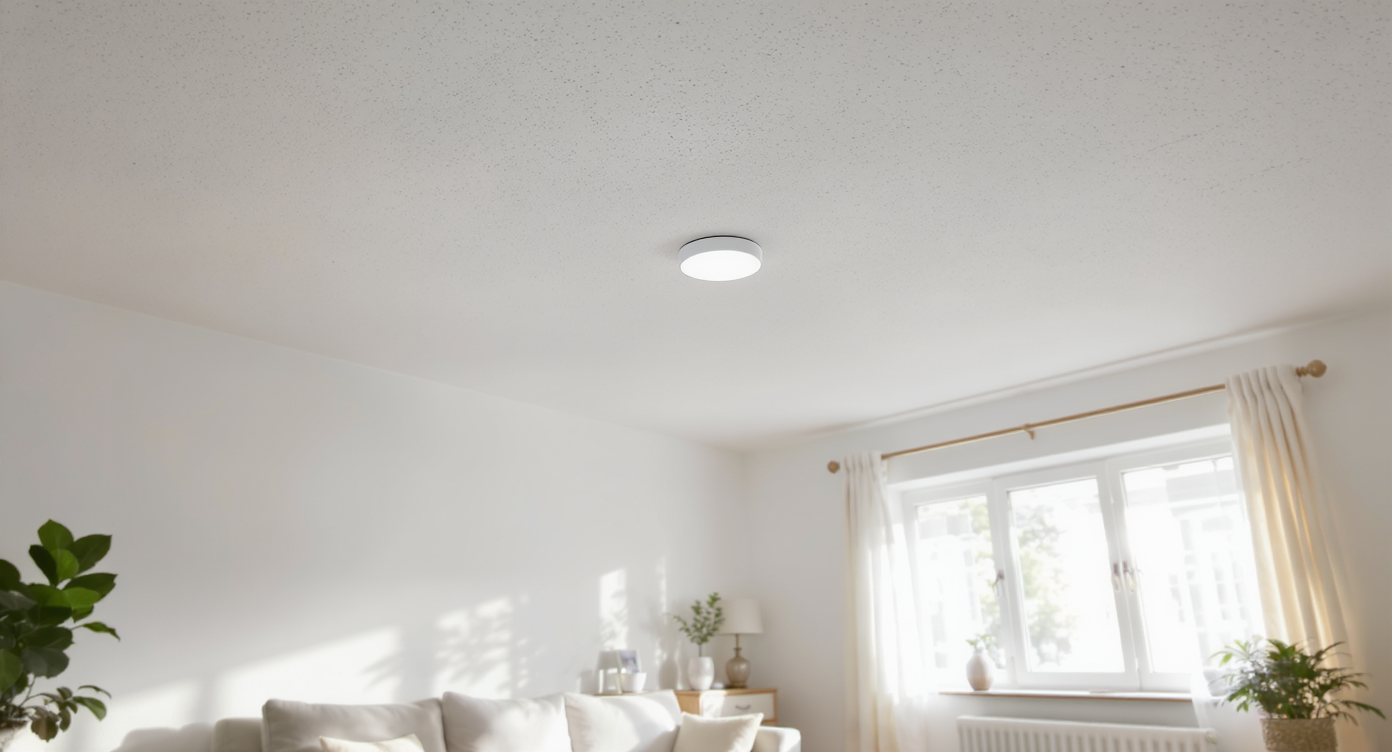TL;DR
For a living room light fixture, size and height matter most: add room length + width (in feet) to get chandelier diameter in inches, and keep about 7 feet of clearance below in living spaces. If you’re torn on style, move whimsical fixtures to smaller rooms and choose a larger, dimmable chandelier or semi-flush that echoes your architecture — a long-tail fix for how to choose the right chandelier size for a living room.
The Real Reason Your Light Fixture Looks “Off” — It’s Not the Style

Choosing the right lighting scale matters; a small flush mount suits modest ceilings and simple rooms perfectly.
Choosing a living room light fixture can feel weirdly high stakes. Living room lighting, chandelier choices, and flush mount vs chandelier debates collide with taste, budget, even pride. Here’s the thing: most disagreements aren’t about the object — they’re about scale, height, and context. Designers often say a “pretty” light can look ugly if it’s the wrong size or in the wrong room. If you’ve got high ceilings, ornate molding, or a statement fireplace, a tiny, whimsical flush mount will read as juvenile or out of place. On the flip side, a well-proportioned chandelier with the right bulb temperature can tie modern furniture to traditional architecture in one click of a dimmer.
Living room lighting that fits (and ends the argument)
Smart living room lighting starts with proportion before personality. Use this simple formula: add the room’s length + width (in feet) to get an ideal chandelier diameter in inches. Experts recommend 7 feet of clearance beneath a living room fixture so it feels generous without head-bumping. - Size: If your room is 14 by 16 feet, 14 + 16 = 30, so aim for about a 30-inch-wide chandelier. For open floor plans, err 10 to 20 percent larger to hold visual weight. - Height: In rooms with 8-foot ceilings, choose a low-profile semi-flush. At 9 to 10 feet, drop the fixture 8 to 12 inches. With 11 feet and higher, a true chandelier can hang 12 to 24 inches and still keep 7-foot clearance. - Style: Mixing styles works when you repeat at least two elements — finish, shape, or motif — elsewhere. A modern saucer pendant can live under traditional crown molding if brass or wood repeats in frames, hardware, or a coffee table. - Light quality: Bare bulbs are harsh; opt for frosted or use shades and a dimmer. For living rooms, 2700K to 3000K LEDs give warm, flattering light; layer 2 to 3 additional sources per 100 square feet with sconces and table lamps. - Cleaning reality: Intricate glass flowers and prismatic crystals look magical on day one and dusty by week three. If it’s ornate, commit to a seasonal clean or place it where hands can reach — powder room, closet, or hall. User insight: Homeowners who relocate whimsical fixtures to smaller spaces (nursery, powder room, walk-in closet) and install a larger, dimmable chandelier in the living room report the debate vanishes along with the glare. Suggested image alt text: brass chandelier sized to room with ceiling medallion in traditional living room. Caption: A larger chandelier hung at 7-foot clearance balances ornate molding.
Anecdote
A homeowner told me she loved the starburst shadows from her floral fixture — until family game night. A dimmer and frosted bulbs tamed the glare, and she stopped hearing “it’s too bright” from across the sofa.
Common mistakes that make a light look “cheap”
These are the little traps that make a light read as “cheap,” even when it isn’t. - Undersized fixture: A delicate 16-inch semi-flush in a 14×16 room will look lost. Aim for the length + width rule to avoid a shrunken effect. - Hugging the ceiling: A fixture installed too tight to a 9–10 foot ceiling flattens the room. Drop it 8–12 inches or switch to a true chandelier to create depth. - Clashing temperature: Warm golds against stark white walls with 2200K bulbs can skew yellow. Use 2700–3000K LEDs or soften the room with warmer textiles. - Too many bare bulbs: Multiple exposed “candle” lamps can feel unfinished and cause glare. Use frosted bulbs, sleeves, or shades, and add a dimmer. - Ignoring architecture: Ornate wainscoting and a marble mantle call for something substantial. Pair traditional envelope with a classic chandelier or a modern icon that’s visually weighty, not cutesy. Suggested image alt text: undersized flush mount in tall living room. Caption: A light that’s too small or too high will cheapen even beautiful millwork.
Pro tips designers use to nail chandelier size, height, and style
To get chandelier size, height, and style right, steal a few trade tricks. Experts recommend blue-taping a circle on the ceiling at the target diameter to preview scale from the sofa before you buy. - Tape test for scale: Mark the ideal diameter on painter’s tape and stand in key sightlines. If it disappears, scale up 10–15 percent. - Ceiling medallion magic: A medallion 2–8 inches wider than the canopy visually anchors fixtures in rooms with heavy molding, making modern lights feel intentional. - Finish strategy: Repeat the fixture’s finish at least twice — brass on a floor lamp and a mirror frame — for cohesion without matchy-matchy. - Height check: Keep roughly 84 inches to the bottom of the fixture in living areas; go lower only over a coffee table where no one walks. - Layered plan: Build a 3-layer plan: ambient (ceiling), task (sconces, reading lamps), accent (picture lights). Set ceilings on dimmers; aim for 20–30 lumens per square foot overall. - Compromise move: If one partner loves “whimsy,” place that playful piece in a bathroom or closet and choose a larger, quieter chandelier for the living room. Everyone wins. Suggested image alt text: modern saucer pendant with ceiling medallion in traditional room. Caption: A medallion bridges modern fixtures and classic millwork.
Anecdotes and real rooms: what actually worked
Real rooms beat theory every time. Here are quick stories that mirror the most common living room light fixture debates — and how they resolved them. - The fairy-flush swap: A couple adored a floral, crystal-studded flush mount for its sparkle, but it looked small and juvenile over an ornate mantle. They moved it to a dressing room where it could hang lower and sparkle in the mirror, then installed a 30-inch linen drum chandelier on a dimmer in the living room. Takeaway: right room, right height. - The “toilet paper” bulb problem: One homeowner couldn’t unsee the thick, exposed bulbs on a whimsical fixture. They replaced them with lower-watt, frosted torpedoes and added two brass sconces. Takeaway: a $30 bulb choice and layered light can shift the mood. - The scale lesson: In a long, high-ceiling parlor, a 20-inch semi-flush looked like a dot. They upgraded to a 34-inch branching chandelier and added a ceiling medallion. Takeaway: in tall rooms, scale up 15–20 percent. - The yes-and solution: A design pair with clashing tastes agreed to keep their quirky piece but “yes-and” it with a second modern element — a Nelson-style saucer over the dining table — while balancing with classic frames and a mantle mirror. Takeaway: repeat a motif to make contrast feel curated, not random.
Visualization Scenario
Picture stepping into a tall, tailored living room at dusk. A 32-inch chandelier floats 12 inches below the ceiling, warm 2700K light on a dimmer washing the crown molding. Brass repeats on a floor lamp and mantle mirror. Two sconces sip light upward, and the coffee table rests safely beneath a soft pool of glow — 7 feet of headroom all around. The room feels finished, not fussy.
FAQ
How high should a living room chandelier hang?
Keep about 84 inches (7 feet) from the floor to the bottom of the chandelier in living spaces; go lower only above a table or ottoman. Designers often advise 30–36 inches above a coffee table if it sits centered beneath.
What size chandelier do I need for my living room?
Add the room’s length and width (in feet) to get the chandelier diameter in inches; a 14×16 room suggests roughly 30 inches wide. For high ceilings or open plans, size up by 10–20 percent.
Is a flush mount or chandelier better for high ceilings?
For ceilings 9 feet and higher, a chandelier or semi-flush that drops 8–24 inches creates depth and better proportions. Experts recommend saving tight flush mounts for 8-foot ceilings and smaller rooms.
How do I mix a modern light fixture with traditional molding?
Repeat two elements — finish, shape, or material — elsewhere and use a ceiling medallion to anchor the look. Keep bulb temperature warm (2700–3000K) and layer sconces to soften contrasts.
How can couples compromise on a living room light fixture?
Agree on scale and height first, then place the more whimsical piece in a smaller room and choose a substantial, dimmable fixture for the living room. This “right room for the right light” approach satisfies both taste and proportion.
Bring it home
Living room lighting works when proportion, height, and light quality come first, and style harmonizes with the room’s bones. If a piece feels pretty-ugly, it’s usually the wrong size, too high, or in the wrong context. Measure, mock up, and don’t be afraid to relocate a whimsical favorite to a smaller space so your main room can carry a larger, dimmable star. Want to test options in minutes? Use a visualization tool like ReimagineHome to preview fixtures at proper scale and temperature before you commit.
.svg)

.svg)
.jpg)





.png)